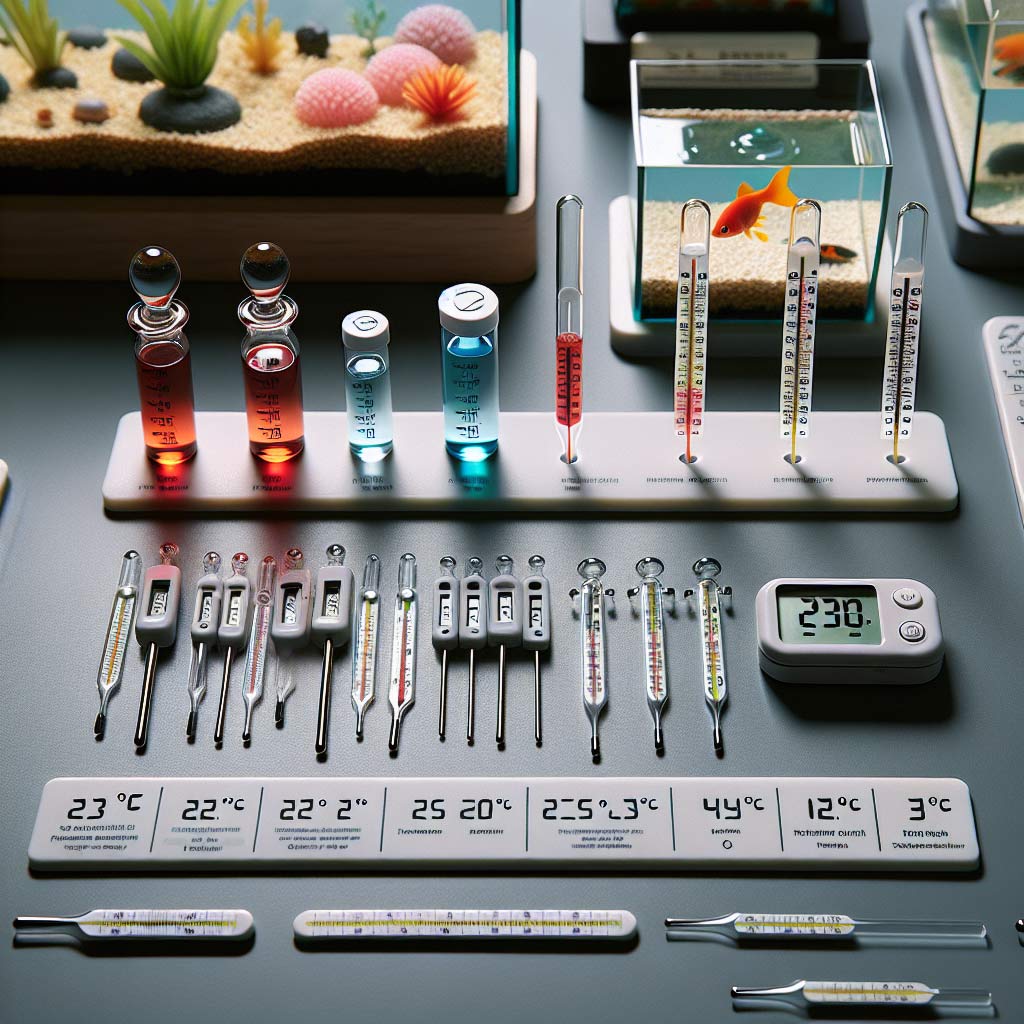
Key Takeaways
- Understanding the importance of accurate temperature control in a freshwater aquarium is crucial for fish health.
- There are several types of thermometers available, each with its own pros and cons.
- Digital thermometers tend to offer the most accurate readings and are generally easier to read.
- Placement and maintenance of the thermometer can significantly affect its accuracy.
- Regular monitoring and calibration of your aquarium thermometer are essential to ensure a healthy environment for your aquatic friends.
Why Your Aquarium’s Temperature Matters
Maintaining the right temperature in your freshwater aquarium isn’t just about keeping the water lukewarm; it’s about creating a stable environment where your fish can thrive. Fish are cold-blooded, meaning their body temperature is regulated by the surrounding water. If the water is too hot or too cold, it can lead to stress, illness, or even death. So, an accurate thermometer isn’t just a tool – it’s a vital part of your aquarium’s ecosystem.
The Role of Temperature in Fish Health
Each fish species has a specific temperature range that they prefer, often down to a few degrees. If the water is too warm, your fish might become hyperactive and consume more oxygen than the water can provide. If it’s too cold, their metabolism slows down, and they may become lethargic and stop eating. That’s why the right thermometer, one you can trust, is so important – it helps you keep the water temperature just right, avoiding these extremes.
Consequences of Incorrect Aquarium Temperatures
Imagine your fish are swimming in water that’s too warm. They’re likely to become stressed, making them more susceptible to diseases. On the flip side, if the water is too cold, their growth and reproductive rates can plummet. Keeping an eye on the temperature with a reliable thermometer can help you avoid these problems and keep your fish swimming happily.
Types of Aquarium Thermometers
Digital vs Analog: A Comparison
When you’re deciding between digital and analog thermometers, think about precision and ease of use. Digital thermometers usually offer a clear numerical display that can be easier to read at a glance. They also tend to be more precise, which is crucial when you’re aiming for a specific temperature range.
Glass Thermometers: Pros and Cons
Glass thermometers are the old-school choice. They’re often inexpensive and can be quite accurate, but they can also be fragile and harder to read. Plus, if they break, they could potentially release hazardous materials like mercury into your aquarium, which is a risk you might not want to take.
Digital Thermometers: Advantages for Modern Aquarists
Digital thermometers, on the other hand, are the go-to for many modern aquarists. They’re durable, usually waterproof, and often come with convenient features like alarms for high and low temperatures. And because they’re digital, they’re less likely to be misread due to parallax error – that’s when you look at an analog thermometer from an angle, and the reading seems off.
Stick-on Thermometers: Are They Reliable?
Stick-on thermometers are a quick and easy option, but they measure the temperature of the glass, not the water. This can be problematic because the glass might be influenced by room temperature, giving you a reading that’s a few degrees off. They’re a decent backup, but for your main thermometer, you’ll want something that measures the water directly. For more detailed information, you can read about different types of aquarium thermometers.
Infrared Thermometers: Non-Contact Temperature Checks
Infrared thermometers are a high-tech option that can measure temperature without even touching the water. They’re super quick and convenient, but they measure the surface temperature, which might not be the same as the temperature deeper in the tank where your fish actually live. So, while they’re cool gadgets, they might not be the best primary thermometer for your aquarium.
How to Select the Best Aquarium Thermometer
When it comes to picking the best thermometer for your DIY freshwater aquarium, there are a few key factors to consider. You want something accurate, durable, and easy to read. After all, the health of your aquatic buddies is on the line. Here’s what to look for:
Accuracy Is Key: Identifying Precision Devices
Accuracy is the most important feature of an aquarium thermometer. A good rule of thumb is to look for a thermometer that can measure within ±1 degree Fahrenheit. This level of precision will help you maintain the optimal temperature range for your fish.
Durability and Lifespan Concerns
You also want a thermometer that’s built to last. Look for sturdy construction and waterproofing, especially if you’re considering a submersible model. A thermometer that’s built well won’t just last longer, it’s also less likely to give you false readings over time.
User-Friendliness: Ensuring Easy Readability and Maintenance
An easy-to-read display is crucial. You should be able to glance at your thermometer and immediately know what the temperature is. Maintenance should be simple, too – the less fuss, the better. You’ve got enough to do caring for your fish; your thermometer shouldn’t add to your workload.
Installation Tips for Optimal Temperature Monitoring
Once you’ve got your hands on the right thermometer, you need to install it correctly to get the best readings. Here’s how:
Best Practices for Placing Your Thermometer
Place your thermometer in a spot where it will measure the average water temperature. That’s usually away from heating and cooling elements and in an area with good water circulation. Avoid corners of the tank that might not represent the overall temperature.
Maintaining Your Thermometer for Accurate Readings
Keep your thermometer clean and free of algae or other debris that might affect its readings. Check it regularly to make sure it’s functioning correctly, and if it’s a digital model, change the batteries as needed to ensure it stays accurate.
Aquarium Thermometers: Expert Insights
As someone who’s spent a lot of time with aquariums, I can tell you that many seasoned aquarists have their favorite types of thermometers. Some swear by the reliability of a good digital thermometer, while others prefer the traditional glass type for its simplicity. But the consensus is clear: accuracy and reliability are the top priorities when it comes to keeping your fish healthy and your aquarium in balance.
Top Picks From Experienced Aquarists
Let’s talk about the thermometers that have earned their place in the hearts of experienced aquarists. The digital probe thermometers, for instance, are a staple due to their precise readings and long-lasting performance. Another favorite is the submersible digital thermometer, which is known for its consistent accuracy and ease of use. These models often come with extra features like alarms, which can be a lifesaver if your tank’s temperature strays from the safe range.
Common Mistakes to Avoid When Using Thermometers
Even with the best equipment, mistakes can happen. One common error is not checking the thermometer’s accuracy regularly. Over time, thermometers can drift from their original calibration, leading to false readings. Another mistake is placing the thermometer too close to the heater or filter, which can give you a skewed temperature reading. Always place your thermometer away from equipment that can affect its accuracy.
Frequently Asked Questions (FAQ)
As you become more familiar with maintaining your aquarium, questions are bound to arise. Here are some answers to the most commonly asked questions about aquarium thermometers:
How often should I check my aquarium’s temperature?
It’s a good practice to check your aquarium’s temperature daily. Consistent monitoring helps you spot any issues early, which is crucial for the well-being of your fish. If your thermometer has a digital readout or an alarm system, it can make this task easier by alerting you to any significant changes.
Can I use the same thermometer for different types of aquariums?
Yes, you can use the same thermometer for different types of aquariums, but you should always make sure it’s cleaned and disinfected between uses to prevent the spread of disease. However, remember that different aquariums might have different temperature requirements, so always adjust accordingly.
What should I do if my thermometer gives inconsistent readings?
If your thermometer is giving inconsistent readings, first check to make sure it’s properly placed in an area with consistent water temperature. If the issue persists, it might be time to recalibrate your thermometer or replace it if it’s an older model. Inaccurate temperature readings can be dangerous for your fish, so don’t delay in addressing this issue.
Is one thermometer sufficient for a large aquarium?
For large aquariums, it’s often wise to use multiple thermometers placed at different locations to ensure an accurate representation of the overall temperature. This helps account for any variations in temperature that can occur in larger tanks.
How can I calibrate my aquarium thermometer?
To calibrate your aquarium thermometer, you’ll need a reliable reference, such as a calibrated lab thermometer. Place both thermometers in the aquarium and compare the readings. If there’s a discrepancy, adjust your aquarium thermometer according to the manufacturer’s instructions, or note the difference and account for it when reading the temperature. Some digital thermometers have a calibration feature, which simplifies this process.




